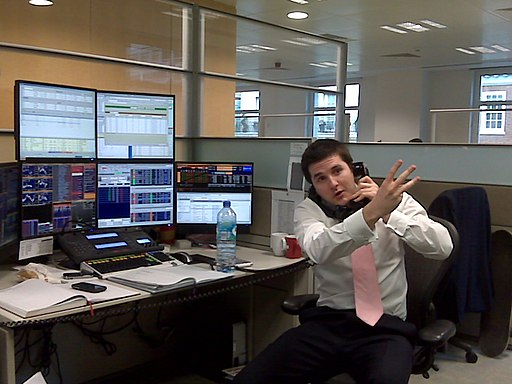
While most investors use digital asset exchanges to buy and sell bitcoin, there is also another market where digital assets are traded. It is called the over-the-counter (OTC) market.
This piece will explain what OTC desks are, how they work, and why they play such an important role for large investors in the digital asset markets.
What is OTC Trading?
OTC brokers work with a network of customers to connect buyers with sellers. These connections can be made through online negotiations, but are often conducted over the phone. OTC desks are commonplace in the traditional financial markets, especially in the bond markets.
OTC trading in bitcoin works in a similar fashion, with a broker facilitating the negotiations between private buyers and sellers. The main job of an OTC broker is to find these buyers and sellers of bitcoin, and to connect them privately. That’s the biggest difference between traditional exchange-based trading and over-the-counter trading.
OTC trades are conducted privately without the use of a public order book. This provides privacy to the clients, but it also allows for the movement of large amounts of bitcoin without disrupting markets or moving the price of bitcoin excessively.
Why OTC Trading Makes Sense
Even on the largest cryptocurrency exchanges, liquidity can be volatile, or just plain inadequate, making it very inefficient for the exchange of large amounts of bitcoin.
When a large order hits the books of a centralized exchange, there’s not much chance for it to get filled at the requested price. Instead, these large orders are often broken up into smaller orders, with each filled by a different counterparty. This leads to price rising for buyers, or falling for sellers, in what’s known in the trading industry as “slippage.”
Using an OTC desk can eliminate slippage since buyers and sellers are matched at a price agreed upon before the trade takes place. OTC desks are also excellent for those looking to remain anonymous. When making an OTC trade there’s no need for identities to be revealed, and because the orders aren’t being entered into a public order book, no one is immediately aware of the trade. This can also help avoid extreme price movements in reaction to large buy and sell orders.
An OTC desk also avoids the problem of order limits and the lack of fiat on-ramps. OTC desks help buyers and sellers customize trades, and avoid the restrictions encountered on centralized, public-facing exchanges.
Who Trades OTC?
The client list of bitcoin OTC trading desks includes high-net-worth individuals, hedge funds, VC funds, bitcoin mining companies, and institutional investors.
Large bitcoin mining operations are usually among the sellers since the OTC desks are the best way for them to exchange the large amounts of mined bitcoin for fiat currency. On the buying side, institutional investors benefit greatly by avoiding exchange-based slippage and trading limits.
OTC Trading Desks
OTC trading is becoming increasingly popular and profitable for trading desks since new OTC brokers continue popping up, even during the bear market of 2018.
Some of the well-known OTC brokers include Circle Trade, Genesis Trading, and Enigma Securities. They have more recently been joined by new OTC trading desks being started by the centralized exchanges.
Many of the major exchanges, including Binance, Coinbase, Poloniex, Bithumb, and Bittrex, have all opened OTC trading desks to service institutional clients and high-net-worth individuals who want to avoid placing large trades on centralized exchanges. This indicates institutional traders have been seeking this kind of off-exchange trading avenue.
While it is impossible to know how large the OTC trading world actually is, several reputable firms have suggested that OTC trades account for 2-3 times the volumes seen on centralized exchanges. Smaller estimates say OTC trades account for 50 percent of all bitcoin trade volumes.
Given the increasing number of OTC desks, and the increasing number of larger trades seen in blockchain records, these estimates probably aren’t too far off the mark. The total trading volume of both exchanges and OTC desks could be in excess of $250 billion per day already. To put that in perspective, it is almost exactly the same size as the global gold markets.
OTC Trading Issues
There aren’t too many issues associated with OTC trades, but the main one is settlement. On a centralized exchange, the exchange holds both the buyer’s and seller’s funds and then distributes them when the trade is completed. That means the exchange is responsible for fund transfers.
When a trade is made with an OTC broker, there is settlement risk between the customer and the broker. Even though part of the OTC broker’s job is to verify the identity and reliability of the parties involved in trades, there is no guarantee that funds will be delivered as promised. To get around this settlement risk, many OTC desks use escrow services as a third-party intermediary.
One other risk involved in OTC trades is the legality of cross-border payments. To complete an OTC transaction, all KYC requirements must be met. This can create multi-jurisdictional issues between sellers and buyers when they reside in different countries.
The Basics of an OTC Trade
Most OTC trades begin with an individual contacting an OTC desk or broker. Although, it’s possible the OTC broker could initiate the contact if it’s with someone they’ve dealt with previously. This initial contact is to express an interest in either buying or selling a specific quantity of bitcoin. If it hasn’t been done previously the broker would conduct the necessary KYC procedures at this point.
Once the KYC is complete, the broker will begin looking for a suitable counterparty for the trade. This process will include negotiations regarding the price of the trade, and perhaps of the trade size as well.
In many cases, the negotiated price will be lower than that found on exchanges, which is an incentive for the buyer to use the OTC route. OTC broker fees are frequently lower than exchange fees as well, providing an additional incentive for using an OTC desk.
Once the broker has agreed on a price and trade size with both the buyer and seller, the trades will be executed and the transaction will be completed. Typically, this means each side will transfer funds to a third-party escrow account held by the broker.
Many OTC brokers have employed regulated custodians to offset settlement risks. Once both sides have transferred funds to the escrow account or custody provider, they are distributed accordingly. In most cases, an OTC desk can settle a trade in less than 24 hours.
Bottom Line
Bitcoin OTC trading brings liquidity to markets that helps to enable institutional participation in the digital asset markets. The one issue with the OTC trading desks is the lack of transparency regarding OTC trades. This obscures trade data, which can be counterproductive because trade data is used to gauge overall market participation and is also used in making investment decisions. However, ultimately, the OTC model is beneficial to the digital asset markets based on the liquidity and market access provided.
Related Reading
- Bitcoin OTC vs. Traditional Brokers
- How Many People Use Bitcoin in 2019?
- Best Performing Cryptocurrency Funds for 2019 (With Scores!)
Still 100% free and full of actionable information for digital asset investors – subscribe to Bitcoin Market Journal today.


